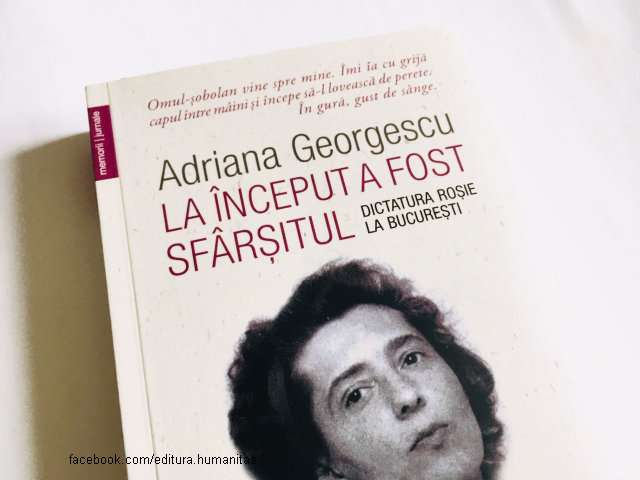Adriana Georgescu
The beginning of communism in Romania and not only in Romania was marked by the cruel crackdown on those opposing the new regime. They included many young people who naively thought with the enthusiasm specific to their age that by protesting frankly and telling the truth the regime would be toppled. In 1945 one of them was Adriana Georgescu, a lawyer and journalist. Aged 25, she was the chief of staff of general Radescu, the last prime minister before the instatement of the Soviet-imposed regime, when she was arrested by the communists and tortured. After being abusively arrested, investigated and beaten by Alexandru Nicolschi, one of the fiercest communist torturers, who became a Securitate general, a mock trial followed in September 1945.

Christine Leșcu, 11.05.2019, 14:30
The beginning of communism in Romania and not only in Romania was marked by the cruel crackdown on those opposing the new regime. They included many young people who naively thought with the enthusiasm specific to their age that by protesting frankly and telling the truth the regime would be toppled. In 1945 one of them was Adriana Georgescu, a lawyer and journalist. Aged 25, she was the chief of staff of general Radescu, the last prime minister before the instatement of the Soviet-imposed regime, when she was arrested by the communists and tortured. After being abusively arrested, investigated and beaten by Alexandru Nicolschi, one of the fiercest communist torturers, who became a Securitate general, a mock trial followed in September 1945.
Adriana Georgescu was sentenced to four years imprisonment for her involvement in the organization of young liberals which the new communist leaders labeled as terrorist. Granted amnesty by King Mihai in 1947, shortly before he stepped down, she was arrested again in the same year. However, she was “kidnapped by her liberal colleagues who helped her escape. Living as a fugitive in Bucharest for a while, on August 2nd 1948 she illegally fled the country with the help of Stefan Cosmovici, who was to become her husband and after taking refuge in Vienna, she settled in Paris. There, helped by the anti-communist writer and journalist Monica Lovinescu, she wrote her first book describing the horrors in the communist prisons.
The book entitled “In the Beginning It Was the End first came out in French in Paris. Adriana Georgescu wrote that book to show the real face of the communist regime which the West did not know about, as it was concealed by propaganda and lies. In addition to the detailed description of the terrible days of detention and torture, Adriana Georgescu also made some portraits of high ranking communists as Lidia Bodea, general manager of Humanitas Publishers told us:
Lidia Bodea: “Adriana Georgescus book contains many details and portraits: the portrait of the first Romanian communist prime minister Petru Groza, portraits of high-ranking communists like Emil Bodnaras and Ana Toma. She was a great writer with a journalists experience too. She used to write film reviews; before 1944 the State Security, the predecessor of Securitate, the communist political police, wanted to hand her over to the Gestapo because she had also attacked the Nazi ideology in the film propaganda. She started to write the book in Paris, shortly after she had fled Romania in 1948 and in 1950-1951, the book took shape. The book was translated into French by Monica Lovinescu. So, the book could be published for the first time in 1951, only a few years after its author had experienced the terror of the communist prison.
One of the portraits made by Adriana Georgescu is that of Alexandru Nicolschi, her fiercest torturer, “the rat-man as the writer dubbed him. Lidia Bodea again: “At that time, Nicolschi was a young man. He was born in Tiraspol in 1915. So in 1945 he was 30; he had finished 8 grades. He was a communist coming from the USSR and first he was arrested as a Soviet agent. During the war, the Romanian authorities turned his sentence into a bearable one. He is the rat-man whom Adriana Georgescu describes as a beast. Nicolschi was a cruel torturer until his serene death. Just before his death, he said he knew what life in prison was like because he himself had been imprisoned. Securitate general Alexandru Nicolschi died peacefully in April 1992.
The first Romanian edition of Adriana Georgescus book “In the Beginning It Was the End was brought out by Humanitas Publishers in 1991. In its foreword, Monica Lovinescu, the writer and journalist who opposed communism at the microphone of Radio Free Europe, highlighted the role of the Romanian dissidence in the first years after the war.
Here is a quote from the preface read out by Lidia Bodea: “We suffer and we will further suffer for quite a while from our reputation of being the East European country with the weakest dissidence. Apart from a few exceptions, that is true for the last decades of the communist regime, but not for the first ones. After 1944, resistance in Romania was larger, more unitary and resolute than in the neighboring countries. And it was longer. In 1945 there was civil society but also the red army in a country under the Soviet influence. In 1989-1990, society, with the well-known remarkable exceptions, appeared neurotic, Adriana Georgescu would have said; in exchange, Europe was no longer divided and the red army was busy at home. In 1945, everything depended on foreigners, now everything is up to us. In principle, in the beginning, there is no way for end to be.
Adriana Georgescu died in 2005 in Great Britain, where she had settled following her second marriage. Recently, Humanitas Publishers brought out the second edition of her book.





























